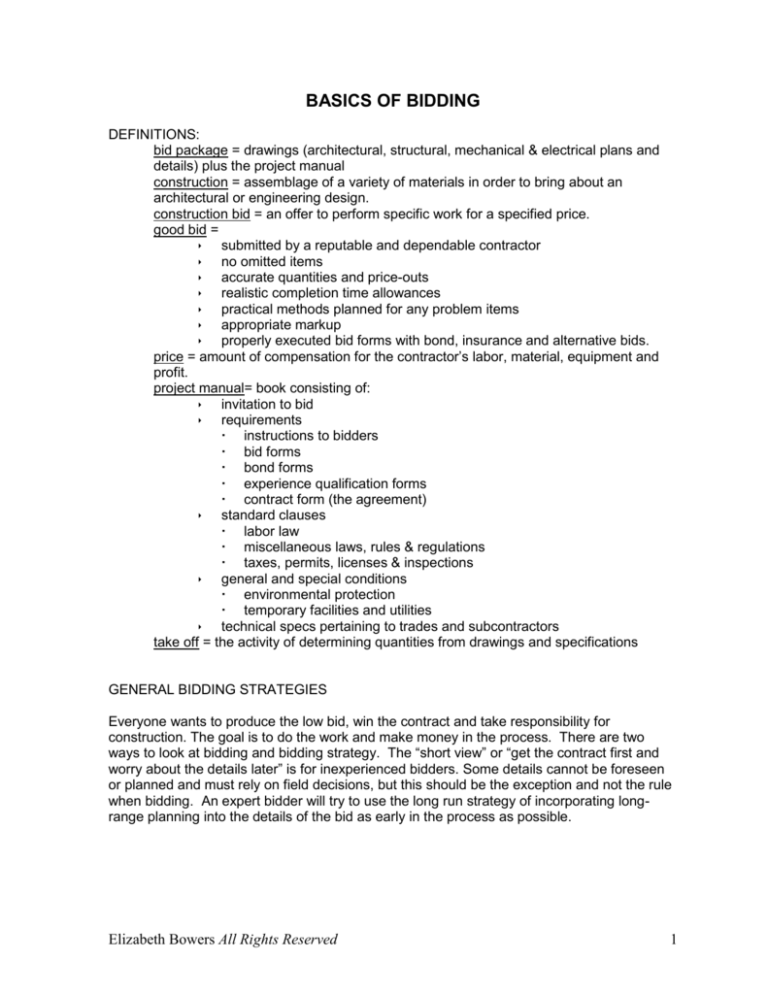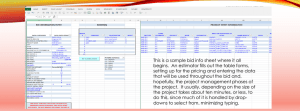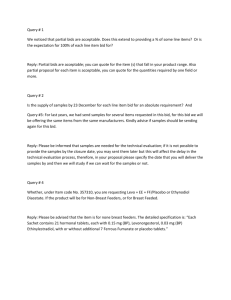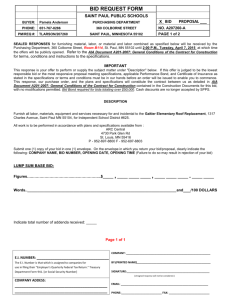
BASICS OF BIDDING
DEFINITIONS:
bid package = drawings (architectural, structural, mechanical & electrical plans and
details) plus the project manual
construction = assemblage of a variety of materials in order to bring about an
architectural or engineering design.
construction bid = an offer to perform specific work for a specified price.
good bid =
submitted by a reputable and dependable contractor
no omitted items
accurate quantities and price-outs
realistic completion time allowances
practical methods planned for any problem items
appropriate markup
properly executed bid forms with bond, insurance and alternative bids.
price = amount of compensation for the contractor’s labor, material, equipment and
profit.
project manual= book consisting of:
invitation to bid
requirements
instructions to bidders
bid forms
bond forms
experience qualification forms
contract form (the agreement)
standard clauses
labor law
miscellaneous laws, rules & regulations
taxes, permits, licenses & inspections
general and special conditions
environmental protection
temporary facilities and utilities
technical specs pertaining to trades and subcontractors
take off = the activity of determining quantities from drawings and specifications
GENERAL BIDDING STRATEGIES
Everyone wants to produce the low bid, win the contract and take responsibility for
construction. The goal is to do the work and make money in the process. There are two
ways to look at bidding and bidding strategy. The “short view” or “get the contract first and
worry about the details later” is for inexperienced bidders. Some details cannot be foreseen
or planned and must rely on field decisions, but this should be the exception and not the rule
when bidding. An expert bidder will try to use the long run strategy of incorporating longrange planning into the details of the bid as early in the process as possible.
Elizabeth Bowers All Rights Reserved
1
IMPORTANT ITEMS IN A GOOD BIDDING STRATEGY
Job Site Walk-Through
Do not miss the opportunity to go on a walk-through. After the bid documents have been
reviewed and you have a general idea of the nature of the project, you should arrange a visit
to the site of construction. You may even want to do a preliminary take-off before the site
visit. When you go for the job-site walk-through, be sure to make notes and ask follow up
questions, submitting them to the architect, general contractor or owner of the project before
you submit your bid. Your investigation of the site and its conditions can make a difference
in your bid and whether you can make money at the price you quote. The walk-through gives
you the opportunity to compare the bid documents to the actual site. Make note of any
differences between the contract documents and the actual site conditions and get them
clarified by the general contractor, architect or owner prior to submitting your bid You will
acquire additional information you may need later. Your perspective on space and
dimensions is heightened as you can develop a better feel for the work you are bidding on. .
If you cannot get a sufficient answer, qualify what your bid is based upon.
You should look at the following:
distance from your company offices
distance from suppliers and subcontractors
working room – how congested will the site be?
equipment availability
source of water
source of power
environmental issues
soil conditions
safety issues – will you need flagmen, barricades, etc.?
security issues
ease in getting materials in and out of the jobsite
availability of secure storage on site
parking
Make a check sheet so that you do not forget what you will be looking for on a job site. This
check sheet should be inclusive enough so that you can use it over and over again on
various projects. It is a good idea to photograph the site as you walk through it to jog your
memory as to a certain condition. Not every item will be checked for every walk-through.
See Example 1
Bid Package
Careful review of the bid documents or bid package is essential in submitting a responsible,
comprehensive bid. Each bidder should carefully examine these documents and do
appropriate take-offs. Note the scale indicated on the drawings and the details. Care should
be taken when measuring dimensions and counting material quantities. Yet, there are other
considerations that when taken into account could affect the bid and whether you will make
money when you perform the contract as you do the work. The Bid Package is made up of
the drawings and the project manual. We will discuss the project manual next.
Elizabeth Bowers All Rights Reserved
2
Project Manual
The Project Manual is also known as the Specifications Book or “Spec Book”. In reviewing
the spec book, another check list will help you cover all the important items that you should
be looking for. Again, not all items will be checked for all projects.
It is suggested that the specifications in the Project Manual be reviewed first. After the specs
have been reviewed and notes taken, attention should then focus on the drawings. Studying
the specs first can direct your attention in what to look for when you review the drawings.
However, everyone has their own way of doing things and whatever way works best for you
is the method you should use. Make note of any discrepancies between the Project Manual
and the drawings and get them clarified before submitting your bid.
Scope of Work: Everyone goes to the part of the spec book that covers their particular
scope of work. This part is important, of course, but it is not the only section that will
influence your bid. Carefully review the scope of work paying particular attention that you
only bid on the work relative to your own scope of work.
General Conditions: Careful attention should be paid to the General Conditions. There
may be costs associated with conforming to the General Conditions in the spec book.
Inattention to the costs related to the General Conditions will cut into, or possibly eliminate,
your profit when you have to comply with them as part of your contract.
Instructions to Bidders: Ignore this section at your peril. Important detailed information is
included in these instructions. If you are not bidding as the General Contractor, you will still
be held to the definitions, interpretations, rules and procedures that are enumerated in this
section of the project manual. Special attention should be given to the formalities of date,
time and place of the bid opening. Note: If you are bidding as a sub-contractor, the
contractor you are giving your quote or bid to needs enough time to incorporate your quote
into his bid.
Information Available to Bidders: This section has instructions on how to get extra
information that you may need or find useful. Environmental research that you either could
not obtain on your own or would be too expensive to obtain on your own is an example of the
type of information that is available to bidders from the owner or architect. Reports on core
sampling would have important information to anyone doing in-the-ground work.
Wage Rate: If the project is funded by the government, note what wage rates you will need
to pay your employees and what monthly paperwork might be required.
Bid Forms: The organization accepting the bids will expect you to use the forms they put
into the spec book. This makes the task of opening and recording bids easier and fairer to
the owner as well as all those submitting bids. If you are a subcontractor, you should discuss
with the general contractor how he might like to have a bid broken down. Don’t assume that
they want to see information presented in the same way you want to present it.
Addenda: Project Manuals are often written with corrections and additional information put
into the addenda of the book. It may contain questions and answers from earlier meetings
that were added at the last minute before printing. This information has been added for a
reason and is important. It may have been too difficult to add it by rewriting the whole book
Elizabeth Bowers All Rights Reserved
3
so it was added at the end. Instructions in the addenda will indicate where the information
applies.
Special Conditions: Take note of any special conditions noted in the project manual that
may affect your working hours, the documentation you need to provide, and anything else
that might affect your price. Many projects are being bid now that follow the USGBC LEED™
Guidelines. You need to understand how this might affect your scope of work such as the
materials you might need to use, sequences you might need to follow and documentation
you might need to provide. If you are unfamiliar with any of the terminology in the Project
Manual, get it clarified prior to submitting your bid.
Payment Terms: Understand what the payment terms are to the general contractor. If you
are bidding as the general, understand what you need to submit to get payment and what the
timeframe is between submitting your invoice and getting paid. Most projects pay monthly.
You might need to carry 30-45 days between the time you submit your invoice and when you
receive payment. Understand these terms prior to submitting your bid.
Another form of Addenda is Bid Bulletins. This is also information that came to light after
the Project Manual was compiled. Bid Bulletins also contain important, pertinent information.
Questions: If you have any questions about any part of the bid documents or the pre-bid
meeting you attended, ask a clarifying question and submit the question to the contact
person in writing. If you think you will have several questions, make a Query List. The
query list is a compilation of your questions and should be submitted all at one time. It will be
more efficient for you and the person answering your questions. Be sure that you ask your
questions well in advance of the deadline for asking questions. Questions and the answers
are distributed to all the bidders so that everyone is on the same footing. In order to get the
information out to everyone, a deadline for questions is established as part of the bidding
process.
Estimate Worksheet or Take-Off Sheet: Detailed information should be gathered first on a
general spreadsheet and then a separate spreadsheet should be used to prepare a
summary. This will help to organize the information and make preparing the bid easier. The
detail sheet should be broken down by categories of work and material with space for the
costs of each, leaving room for totals. The summary worksheet will have the totals only,
labeled by categories in the scope of work. See Example 2
ALL OF THE DETAILS OF AN ESTIMATE ARE TOO NUMEROUS FOR THIS WORKSHOP
AND ARE NOT INCLUDED HERE.
Elizabeth Bowers All Rights Reserved
4
PACKAGING THE BID
After you have reviewed all the bidding documents, the bid forms, bid bond (if required), the
instructions regarding the formalities and have completed all your estimation figures including
overhead and profit, you are ready to compile your bid. This is another time where a checklist
could be helpful to the bidder in preparing the bid. The checklist should include all items that
must be completed during the entire estimating process. This ensures that everything is
accounted for and the bid can be submitted correctly and on time. This is an easy way to
keep track of the details of bid submission as stipulated in the bid documents. Review your
site notes, sketches and photographs one more time to see if anything jogs your memory.
Bid Pricing
The bid form supplied to the subcontractor with the plans and specifications may ask for one
or more forms of bids: Lump Sum bid, a Unit Price bid or a Breakdown of Materials, Labor
and Equipment bid. The general contractor will have similar requirements for his bid
submission. The general contractor may also be required to submit a list of potential
subcontractors that have tendered acceptable bids. Be sure to follow the instructions so that
your bid is considered acceptable. Note how the general might want pricing broken out. Also,
be sure to note what specific packages you might be bidding. The general might want to see
separate pricing for drywall, framing, doors, ceilings and hardware. Understand this before
you present your bid. Understand what the general wants you to include and what he might
want excluded from each package. If you include too much, you might not get the project.
Too little, and you might find yourself financially responsible for it during the project.
Lump Sum Pricing: This is the most common request for a bid. The bidder estimates the
costs for labor, material, equipment, overhead, profit, bonds, permits, insurance, fees and
taxes and totals them into a lump sum figure and submits it as a price for doing the work. If
you have developed a good working relationship with a general contractor, you can offer cost
savings suggestions to him to help you get an edge. These are known as alternates and
must be stated as such. Always price your work “per plans and specifications”. Alternates
can be a way to help you get the project and develop a good working relationship with a
general contractor. Everyone is always looking for the idea that helps them get the job. This
is where your experience really helps.
Unit Pricing: The quoted estimation of the price of units that will go into construction of the
scope of work is unit pricing. Usually the unit price is added to the lump sum bid for
reference purposes. The owner may request that the unit cost be added so that, should any
additions or deletions to the work occur, the price can already be noted and a price be put on
work order, change order or addendum. The process of applying these unit prices varies
from contract to contract, but details about how the unit prices are to be used on the project
will usually be found in the supplementary conditions of the contract documents.
Another reason for a unit price estimate is that the general contractor can use it to compare
accuracy between subcontractor quotes. If the lump sum prices are similar, but the unit
prices are different, then one of the subcontractors may have made an error in his quote.
Any questions about a bid or quote must be answered before a bid is accepted.
Elizabeth Bowers All Rights Reserved
5
Bid Cover Sheet
The bid cover sheet does not have the breakdown of costs on it but does have all the basic
general information required on the bid form. The example offered in this workshop is similar
to the bid forms issued in many local bid document sets. See Example 3
The Bid Form
The bid which is often called the tender is sometimes submitted on a form of the contractor’s
or the owner’s choosing. In any case, it usually contains the following information:
1. The name and address of the project
2. The identity of the owner
3. The identity of the bidding contractor
4. A description of the work to be done
5. A list of the bid documents
6. A list of the addenda
7. The bid price
8. The duration or completion date of the project
9. Signatures of the bidders or corporate officer if the company is incorporated
10. The time, date and place of the bid.
11. Alternates or unit prices required by the bid documents
Either on the bid form or in a letter, the bidding contractor must declare that the bidder
agrees to hold the bid open for acceptance by the owner at the price specified for a period of
time (usually 60 days) and that the bidder will comply with all other bid requirements.
NOTE:
Compiling a bid can be a complicated task, but if you do your homework and take care to
review all the documents, gather all the information you may need and pay attention to
details, it can be a successful process. This information contained in these pages is only an
overview of the information you will ultimately need.
Suggested Reading: These books may be available at your local library. You may want
to purchase any or all of these books.
Basic Estimating for Construction by James A. S. Fatzinger; published by Prentice Hall
ISBN 0-13-518267-0
Fundamentals of Construction Estimating by David Pratt; published by Delmar Publishers
ISBN 0-8273-6135-1
Bidding for Contractors: How to Make Bids that Make Money by Paul J. Cook; published by
RS Means; ISBN-10: 0876292708
Means Estimating Handbook published by RS Means CMD Group ISBN 0-87629-177-9
Plan Reading & Material Takeoff by Wayne J. DelPico; published by RS Means CMD Group
ISBN 0-87629-348-8
Elizabeth Bowers All Rights Reserved
6
Example 1
SITE VISIT CHECK LIST
Project
Date of visit:
Address
Distance from business
General weather conditions
Access roads
Site conditions
Adjacent Structures
Obstructions
Soil data
Soils report available?
From:
Water available
Electric available
Telephone service
Sewage/Portajohns
Garbage/Dumpsters
Gas
Parking and Storage
Soil disposal:
Contamination
Site History
Other Comments:
Elizabeth Bowers All Rights Reserved
7
ESTIMATING WORKSHEET
Example 2
Job
Date
Page #
Estimated by
Description
Qty
Unit
Elizabeth Bowers All Rights Reserved
Materials
Unit Price
Labor
Total
8
Example 3
ACME CONSTRUCTION
Date _________________________________ Bid # ____________________________
Project _________________________________________________________________
Project Address __________________________________________________________
Owner __________________________________________________________________
Contact Person_________________________ Phone # __________________________
Owner Address ___________________________________________________________
BIDDING
Division(s) ___________________________ Sections ____________________________
Summary of Work _________________________________________________________
________________________________________________________________________
________________________________________________________________________
Addendum noted __________________________________________________________
Base Bid ________________________
Special Information:
ALTERNATE #1 ________________________
ALTERNATE #2 ________________________
ALTERNATE #3 ________________________
ALTERNATE #4 ________________________
ALTERNATE #5 ________________________
Bid Bond Included
Taxes Included
Elizabeth Bowers All Rights Reserved
9





